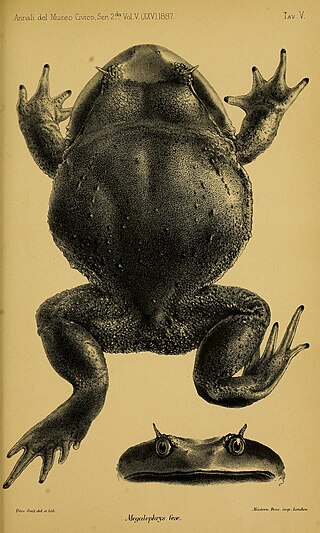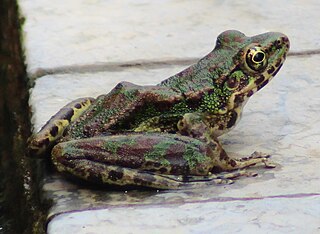Boulenophrys parva is a specie of horned frog found in South Asia, Southeast Asia, eastern India, Nepal, Bangladesh, Burma, western Thailand, southern China, northern Laos and Vietnam. Perhaps because of its wide distribution, Boulenophrys parva is known under many common names, including concave-crowned horned toad, lesser stream horned frog, mountain horned frog, brown horn frog, Burmese spadefoot toad, and small spadefoot toad. It inhabits evergreen broadleaf forests alongside streams.

Brachytarsophrys feae is a species of amphibian in the family Megophryidae. It is found in southern China and northern Myanmar, Thailand, and Vietnam; it is likely to occur in Laos. The specific name feae honors Leonardo Fea, an Italian explorer, zoologist, and naturalist.
Odorrana absita is a species of frog in the family Ranidae. It is found in southern Laos and central Vietnam. It was originally described in genus Huia. Its type locality is Xe Sap National Biodiversity Conservation Area in southern Laos.
Nanorana yunnanensis, commonly known as Yunnan paa frog, Yunnan spiny frog, Bourret's paa frog or Bourret's frog, is a species of frog in the family Dicroglossidae. It is found in southwestern China, Vietnam, Myanmar, northern Thailand, and likely in the intervening Laos. Its natural habitats are small and large streams in montane forests, scrub vegetation and grasslands, and it has also been found in ditches. It is threatened primarily by collection for human consumption, but also by habitat loss caused by agricultural development and infrastructure development.
Odorrana anlungensis is a species of frog in the family Ranidae that is endemic to China: it is only known from its type locality, Mount Longtou in Anlong County, Guizhou. Its common name is Lungtou frog or Anlung odorous frog. Little is known about this species found in shaded hill streams 2-3m wide in forested areas.
The Tonkin frog is a species of frogs in the family Ranidae. It is found in northern Vietnam and in adjacent southern China. The specific name is derived from Bac Bo, the Vietnamese name for northern Vietnam, as the species was first described from there.
Odorrana bolavensis is a species of frog in the family Ranidae. It is endemic to the Bolaven Plateau, Laos. Its natural habitats are wet evergreen forest. It can be found at night on rocks and vegetation along rocky streams, occasionally on leaf-litter or tree branches away from streams.
Odorrana chapaensis is a species of frog in the family Ranidae that is found in southern Yunnan in China and in northern Vietnam. It is likely that it also occurs in nearby areas of Laos.
Amolops daorum is a species of frog in the family Ranidae. It is known from its type locality in the vicinity of Sa Pa in northern Vietnam near the Chinese border, Hong Kong, and Houaphanh Province in eastern Laos; presumably it also occurs the intervening areas. The Hong Kong record is considered suspicious, however.

Graham's frog – also known as the diskless-fingered odorous frog – is a species of frog in the family Ranidae. It is found in China and Vietnam. Presumably it is also found in Myanmar in areas adjacent to its Chinese distribution area.
Odorrana hainanensis is a species of frogs in the family Ranidae that might be endemic to Hainan Island, China; there is one record from Guangxi. Prior to its description in 2001, it was confused with Odorrana andersonii.
Odorrana hejiangensis is a species of frog in the family Ranidae that is endemic to China. It is found in the Yangtze River Valley of southern Chongqing and northern Guizhou, with an isolated record in western Guangxi. Its name refers to the type locality, Hejiang County in northern Sichuan. Its natural habitats are shaded hill streams and the surrounding riparian forests. Its status is insufficiently known.
Odorrana jingdongensis is a species of frogs in the family Ranidae. It is known from southern China and northern Vietnam, though it quite likely also occurs in the adjacent areas in Laos and in Myanmar. Its name refers to its type locality, Jingdong Yi Autonomous County in Yunnan. Common name Jingdong frog has been coined for it.
Odorrana junlianensis, also known as the Junlian odorous frog, is a species of frogs in the family Ranidae. It is found in southern China and in the northernmost Laos and Vietnam. Its type locality is the eponymous Junlian County in Sichuan.
Odorrana kuangwuensis is a species of frog in the family Ranidae that is endemic to China. It is found in northeastern Sichuan and northwestern Hubei. Its name refers to the type locality, Mount Guangwu in Nanjiang County, northern Sichuan.
Odorrana lungshengensis is a species of frogs in the family Ranidae that is endemic to China. It is found in northeastern Guangxi, southwestern Hunan, and eastern Guizhou. Its natural habitats are hill streams in broad-leaf forests. It is becoming rare due to habitat loss.
Odorrana morafkai is a species of frogs in the family Ranidae. It is found in eastern Cambodia, southern Laos, and central Vietnam. This frog is highly unusual because it turns from its daytime green color to brown at night.
Odorrana orba is a species of frog in the family Ranidae. It is found in southeastern Laos and central Vietnam. The specific name orba is Latin for "orphan", referring to the fact that this species was—at the time of species description—known in Vietnam only from a single juvenile.

Odorrana schmackeri is a species of frog in the family Ranidae. It is endemic to China and distributed in southern and south-central China. Reports from Thailand and Vietnam require confirmation.
Feihyla palpebralis is a species of frog in the family Rhacophoridae, sometimes known as the Vietnamese bubble-nest frog or the white-cheeked small treefrog. In addition to its type locality, Langbian Plateau in southeastern Vietnam, it is found in southern China and northern Vietnam south to Tam Dao, and is expected to be found in the intervening Laos and Vietnam.



